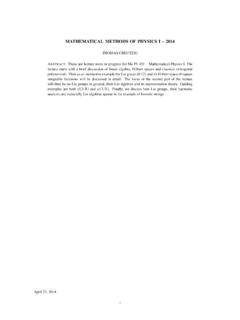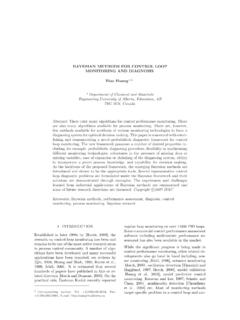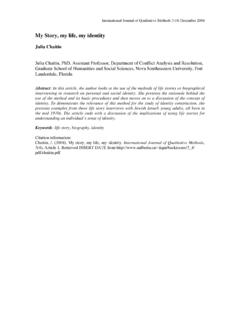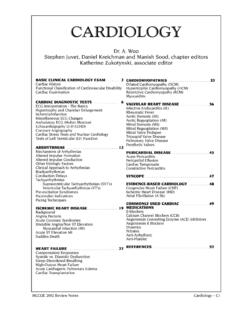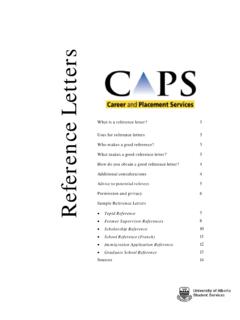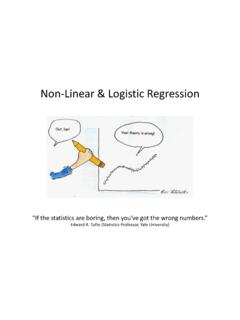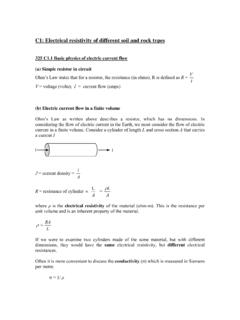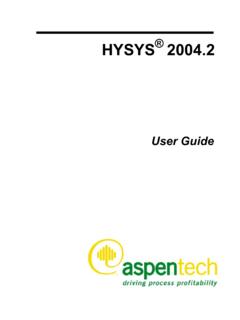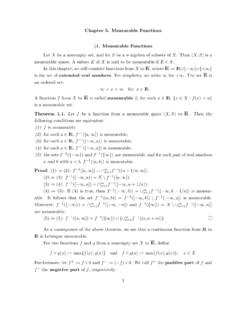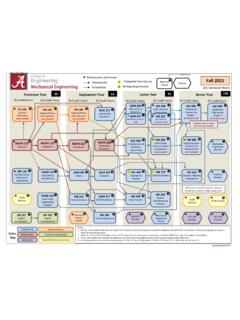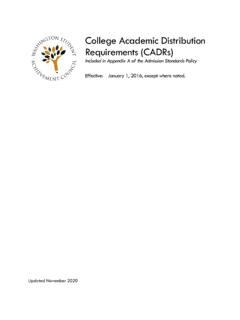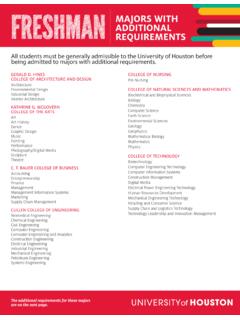Transcription of Algorithms for Reinforcement Learning - University of Alberta
1 Algorithms for Reinforcement LearningDraft of the lecture published in theSynthesis Lectures on Artificial Intelligence and Machine LearningseriesbyMorgan & Claypool PublishersCsaba Szepesv ariJune 9, 2009 Contents1 Overview32 Markov decision Preliminaries .. Markov Decision Processes .. Value functions .. Dynamic programming Algorithms for solving MDPs ..163 Value prediction Temporal difference Learning in finite state spaces .. TD(0) .. Monte-Carlo .. ( ): Unifying Monte-Carlo and TD(0) .. Algorithms for large state spaces .. ( ) with function approximation .. temporal difference Learning .. methods ..36 Last update: March 12, choice of the function space ..424 A catalog of Learning problems .. Closed-loop interactive Learning .. Learning in bandits .. Learning in bandits .. Learning in Markov Decision Processes .. Learning in Markov Decision Processes .. Direct methods .. in finite MDPs.
2 With function approximation .. Actor-critic methods .. a critic .. an actor ..655 For further Further reading .. Applications .. Software .. Acknowledgements ..73A The theory of discounted Markovian decision Contractions and Banach s fixed-point theorem .. Application to MDPs ..78 AbstractReinforcement Learning is a Learning paradigm concerned with Learning to control asystem so as to maximize a numerical performance measure that expresses a long-termobjective. What distinguishes Reinforcement Learning from supervised Learning is thatonly partial feedback is given to the learner about the learner s predictions. Further,the predictions may have long term effects through influencing the future state of thecontrolled system. Thus, time plays a special role. The goal in Reinforcement learningis to develop efficient Learning Algorithms , as well as to understand the Algorithms merits and limitations. Reinforcement Learning is of great interest because of the largenumber of practical applications that it can be used to address, ranging from problemsin artificial intelligence to operations research or control engineering.
3 In this book, wefocus on those Algorithms of Reinforcement Learning that build on the powerful theory ofdynamic programming. We give a fairly comprehensive catalog of Learning problems,2 RewardStateActionSystemSystemControllerC ontrollerFigure 1: The basic Reinforcement Learning scenariodescribe the core ideas together with a large number of state of the art Algorithms ,followed by the discussion of their theoretical properties and : Reinforcement Learning ; Markov Decision Processes; temporal difference learn-ing; stochastic approximation; two-timescale stochastic approximation; Monte-Carlo meth-ods; simulation optimization; function approximation; stochastic gradient methods; least-squares methods; overfitting; bias-variance tradeoff; online Learning ; active Learning ; plan-ning; simulation; PAC- Learning ;Q- Learning ; actor-critic methods; policy gradient; naturalgradient1 OverviewReinforcement Learning (RL) refers to both a Learning problem and a subfield of machinelearning.
4 As a Learning problem, it refers to Learning to control a system so as to maxi-mize some numerical value which represents a long-term objective. A typical setting wherereinforcement Learning operates is shown in Figure 1: A controller receives the controlledsystem s state and a reward associated with the last state transition. It then calculates anaction which is sent back to the system. In response, the system makes a transition to anew state and the cycle is repeated. The problem is to learn a way of controlling the systemso as to maximize the total reward. The Learning problems differ in the details of how thedata is collected and how performance is this book, we assume that the system that we wish to control is stochastic. Further,we assume that the measurements available on the system s state are detailed enough sothat the the controller can avoid reasoning about how to collect information about the3state.
5 Problems with these characteristics are best described in the framework of MarkovianDecision Processes (MDPs). The standard approach to solve MDPs is to use dynamicprogramming, which transforms the problem of finding a good controller into the problemof finding a good value function. However, apart from the simplest cases when the MDP hasvery few states and actions, dynamic programming is infeasible. The RL Algorithms thatwe discuss here can be thought of as a way of turning the infeasible dynamic programmingmethods into practical Algorithms so that they can be applied to large-scale are two key ideas that allow RL Algorithms to achieve this goal. The first idea is touse samples to compactly represent the dynamics of the control problem. This is importantfor two reasons: First, it allows one to deal with Learning scenarios when the dynamics isunknown. Second, even if the dynamics is available, exact reasoning that uses it mightbe intractable on its own.
6 The second key idea behind RL Algorithms is to use powerfulfunction approximation methods to compactly represent value functions. The significanceof this is that it allows dealing with large, high-dimensional state- and action-spaces. Whatis more, the two ideas fit nicely together: Samples may be focused on a small subset of thespaces they belong to, which clever function approximation techniques might exploit. It isthe understanding of the interplay between dynamic programming, samples and functionapproximation that is at the heart of designing, analyzing and applying RL purpose of this book is to allow the reader to have a chance to peek into this beautifulfield. However, certainly we are not the first to set out to accomplish this goal. In 1996,Kaelbling et al. have written a nice, compact survey about the approaches and algorithmsavailable at the time (Kaelbling et al., 1996). This was followed by the publication of the bookby Bertsekas and Tsitsiklis (1996), which detailed the theoretical foundations.
7 A few yearslater Sutton and Barto, the fathers of RL, published their book, where they presented theirideas on RL in a very clear and accessible manner (Sutton and Barto, 1998). A more recentand comprehensive overview of the tools and techniques of dynamic programming/optimalcontrol is given in the two-volume book by Bertsekas (2007a,b) which devotes one chapterto RL times, when a field is rapidly developing, books can get out of datepretty quickly. In fact, to keep up with the growing body of new results, Bertsekas maintainsan online version of his Chapter 6 of Volume II of his book, which, at the time of writingthis survey counted as much as 160 pages (Bertsekas, 2010). Other recent books on thesubject include the book of Gosavi (2003) who devotes 60 pages to Reinforcement learningalgorithms in Chapter 9, concentrating on average cost problems, or that of Cao (2007) whofocuses on policy gradient methods. Powell (2007) presents the Algorithms and ideas from anoperations research perspective and emphasizes methods that are capable of handling large1In this book, RL is called neuro-dynamic programming or approximate dynamic programming.
8 Theterm neuro-dynamic programming stems from the fact that, in many cases, RL Algorithms are used withartificial neural spaces, Chang et al. (2008) focuses on adaptive sampling ( , simulation-basedperformance optimization), while the center of the recent book by Busoniu et al. (2010) isfunction , by no means do RL researchers lack a good body of literature. However, what seemsto be missing is a self-contained and yet relatively short summary that can help newcomersto the field to develop a good sense of the state of the art, as well as existing researchers tobroaden their overview of the field, an article, similar to that of Kaelbling et al. (1996), butwith an updated contents. To fill this gap is the very purpose of this short the goal of keeping the text short, we had to make a few, hopefully, not too trou-bling compromises. The first compromise we made was to present results only for the totalexpected discounted reward criterion. This choice is motivated by that this is the criterionthat is both widely used and the easiest to deal with mathematically.
9 The next compro-mise is that the background on MDPs and dynamic programming is kept ultra-compact(although an appendix is added that explains these basic results). Apart from these, thebook aims to cover a bit of all aspects of RL, up to the level that the reader should beable to understand the whats and hows, as well as to implement the Algorithms , we still had to be selective in what we present. Here, the decision was to focuson the basic Algorithms , ideas, as well as the available theory. Special attention was paid todescribing the choices of the user, as well as the tradeoffs that come with these. We triedto be impartial as much as possible, but some personal bias, as usual, surely remained. Thepseudocode of almost twenty Algorithms was included, hoping that this will make it easierfor the practically inclined reader to implement the Algorithms target audience is advanced undergaduate and graduate students, as well as researchersand practitioners who want to get a good overview of the state of the art in RL who are already working on RL might also enjoy reading about parts of the RLliterature that they are not so familiar with, thus broadening their perspective on RL.
10 Thereader is assumed to be familiar with the basics of linear algebra, calculus , and probabilitytheory. In particular, we assume that the reader is familiar with the concepts of randomvariables, conditional expectations, and Markov chains. It is helpful, but not necessary,for the reader to be familiar with statistical Learning theory, as the essential concepts willbe explained as needed. In some parts of the book, knowledge of regression techniques ofmachine Learning will be book has three parts. In the first part, in Section 2, we provide the necessary back-ground. It is here where the notation is introduced, followed by a short overview of thetheory of Markov Decision Processes and the description of the basic dynamic programmingalgorithms. Readers familiar with MDPs and dynamic programming should skim throughthis part to familiarize themselves with the notation used. Readers, who are less familiar5with MDPs, must spend enough time here before moving on because the rest of the bookbuilds heavily on the results and ideas presented remaining two parts are devoted to the two basic RL problems (cf.)
